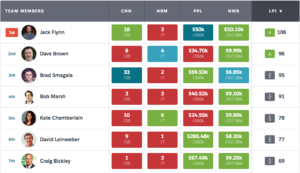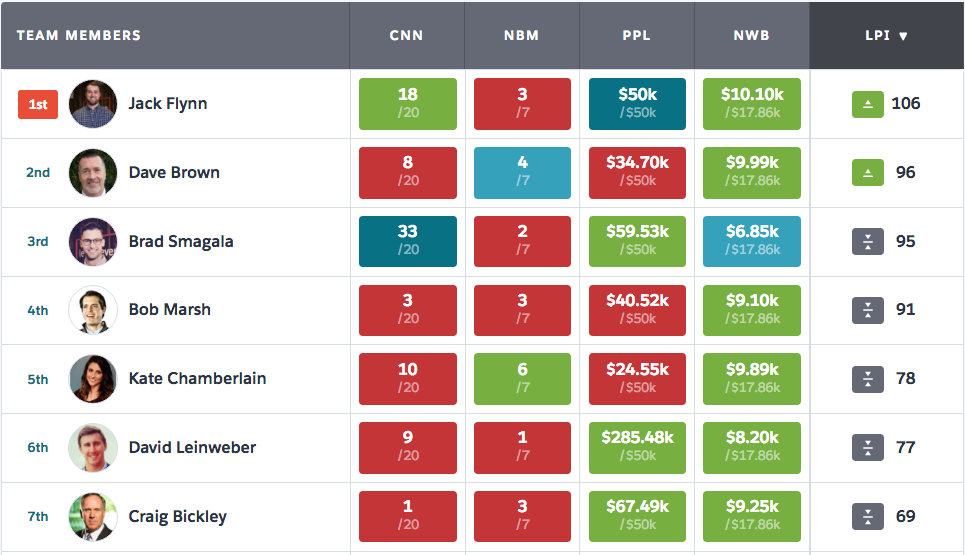Sales managers don’t actually manage “sales.” They manage a team of people who perform day-to-day activities that lead to sales. And research has found that the only way for a sales leader to affect sales performance is to coach and motivate those behaviors within their team members.
 But you can’t manage what you don’t measure, which is why many sales teams have adopted a sales activity tracking spreadsheet. Often, they do this by extracting activity data from their CRM system and importing it into an Excel spreadsheet. Manipulating the data is easier that way. You can put multiple data points in one sheet, insert formulas and show people which teams are on pace, behind pace and ahead of pace to hit their activity goals.
But you can’t manage what you don’t measure, which is why many sales teams have adopted a sales activity tracking spreadsheet. Often, they do this by extracting activity data from their CRM system and importing it into an Excel spreadsheet. Manipulating the data is easier that way. You can put multiple data points in one sheet, insert formulas and show people which teams are on pace, behind pace and ahead of pace to hit their activity goals.
While this tool can be helpful for transparency within an organization, the process to create it is very inefficient. Here are three reasons why you might be wasting time and resources with a sales activity tracking spreadsheet (as well as a suggested tool to replace it).
A sales activity tracking spreadsheet is a time suck.
Everything about this activity tracking tool must be put together manually. You have to go into your CRM system and extract the activity data, then import it into the spreadsheet. You probably also include formulas and macros — maybe even pivot tables — to break down and analyze the data. More than likely, you send out the spreadsheet to your executive team and frontline sellers.
The sales activity tracking spreadsheet puts the data into a more digestible form. But creating it is no easy task. As your company gets bigger, this process will get radically more complicated and time-consuming. Being metrics-driven is important, but not at the cost of a leader’s time and productivity.
A sales management system automatically tracks activity data within a CRM system and presents it back to reps and managers in an easily digestible way.
In addition, personalized performance scorecards also calculate pace to goal and alert reps and managers when a metric falls behind.
A sales activity tracking spreadsheet isn’t very accessible.
After you put all that work into creating your activity spreadsheet, there’s no guarantee that anyone actually looks at it. Sure, you can email it out to the team as many times you want (some teams do so as many as three times a day).
But that assumes the people you’re emailing check the spreadsheet every time. No one on your team is begging for yet another email to pile up in their inbox. Yes, tracking activity metrics is important. But how does the information help reps when it’s already old by the time they get it? And even if a rep does want to check, she’ll have to search through her emails, download the report and try to digest the information.
Sales management systems prioritize the most important activities for reps and managers at any given moment. A miniature scorecard follows users around throughout their CRM system, keeping their most important metrics front-and-center.
A sales activity tracking spreadsheet doesn’t help your reps.
Even if you take the time to put together your sales activity tracking spreadsheet, and your reps eagerly open it to view their most recent data, how will they know what do with it? A spreadsheet won’t help a rep determine what she, specifically, should do right now to ensure she achieves quota in the future.
Within a sales management system, real-time data tells reps exactly how much of each key sales activity they need to complete goals. When they fall behind, a pacing algorithm instructs them what they need to do before leaving the office each day to get back on track. Managers can also initiate coaching sessions with reps right within the system.
Let’s be clear: There’s nothing wrong with tracking, managing and coaching the key critical activities that lead to sales for your team. That’s probably the most important job of a sales leader. But a sales activity spreadsheet is just an arduous way to do so, and utilizing a sales management solution can save you time, make metrics more visible and help reps make better decisions with how to use their time.
Curious what kind of ROI you could see from an activity management tool? Click the image below to use our three-step calculator.




